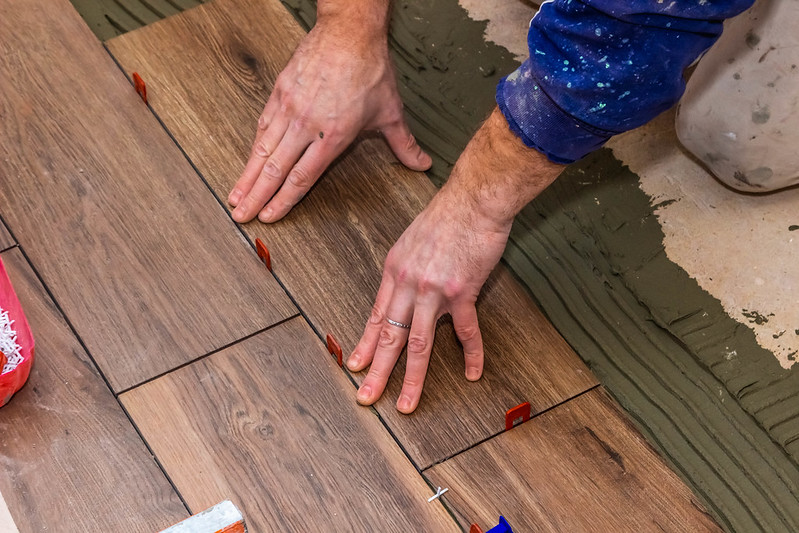Are you a do-it-yourselfer opting for handy guidance on how to fix water damaged floating floor? When it comes to DIY home improvements, floating floor installation is a popular choice because of its ease and speed of installation.
A limited budget may result in problems such as undesired water damage and other incidents. Go along with this manual; think of it as a problem-solver because we want you to be efficient and convenient.

Flooring Based On Materials
The following are the three types of flooring that are most frequently constructed using floating floor methods:
Laminate flooring
A great example of a floating floor that is practically never glued down. The floating approach allows the flooring to expand and contract without buckling in response to variations in relative humidity.
A modified tongue-and-groove technique, sometimes known as “click-lock” or “fold and lock,” is used to attach laminate flooring boards along the edges. The shape of the interlocking grooves varies between manufacturers due to the proprietary connecting methods.
- Luxury vinyl flooring (LVF)
Also known as vinyl plank flooring, LVF is a form of vinyl flooring that snaps together board-to-board, similar to how laminate planks do. However, other types can be attached to the subfloor instead.Tiny tongues and grooves are designed into the boards, which allow them to lock together when they are assembled.
- Engineered wood flooring
It can be adhered to a plywood subfloor using nails or staples. However, there are various brands of flooring that are fitted as floating floors.Engineered wood flooring has a decorative top layer bonded to a plywood or MDF core, similar to laminate flooring.
Reminder
Water and laminate flooring do not mix. Porcelain or ceramic tile, luxury vinyl plank flooring, and sheet vinyl flooring are considered water-resistant.
On the other hand, solid hardwood, bamboo, and engineered wood flooring should be carefully considered before installing a full bathroom with a shower or bathtub.
Incorrectly installed laminate flooring will fail in high-moisture areas. Laminate flooring can withstand water exposure if built as directed by the manufacturer.
Fixing Water Damaged Floor
This guideline will mainly focus on laminate flooring, but this also applies to other types of floating floors.
Step #1. Stop the water from doing more damage
Start by finding the source of the water. This is the first thing you should investigate if it weren’t caused by a minor spill or an unintentional accident.
Concentrate your efforts first on repairing any leaks in other areas of the house, such as a dishwasher or washing machine.
Once the water has been turned off, shift your focus back to the damaged boards to determine the full scope of the damage.
Step #2. Get rid of excessive fluid and moisture
Standing water on top of laminate flooring
Mop up any standing water, as water might seep into the laminate’s seams. The laminate’s cut and exposed edges make it more problematic in the area around the edges.
Using a wet-dry vacuum, extract any water that has seeped into the edges or open seams.
Water underneath the laminate flooring
The water needs to be drained as soon as possible. A little water on the flooring can be cleaned up by pulling up any quarter-round (shoe molding) or baseboards that have been left in place.
Using a wet-dry vacuum may be an option if the water doesn’t seem to be a problem.
Step #3. Check the affected area very keenly
Step on each damaged board to feel for any changes or movement that could indicate water underneath. Look for visual changes in the laminate flooring.
After exposure to any quantity of water, damaged planks often discolor and buckle, becoming deformed. It would be beneficial if you concentrated on these laminate boards.
Make a note or a flag of each board that stands out.
Step #4. Damaged laminate planks must be removed as soon as possible
After the quarter-round and baseboards have been removed, it should be easy to remove floorboards parallel to the spill. The last course of parallel laminate boards should slant upward.
Then, you can gradually add up the number of boards you’re taking up as needed. It is challenging to remove floorboards that run perpendicular to a spill and the initial layer of boards.
Alternatively, you can use any tool or knife that is thin enough to get under the board and lift it from the barrier beneath. This is a process that should be taken slowly.
Laminated floors are made with a locking system, so it is a simple operation to put them together.
Is It Possible To Repair Laminate Flooring That Has Swelled?
A swelled board will not return to its original shape if left unattended. Replacing the swelling laminate boards is the best solution.
Read more information about how to fix water damaged swollen laminate floor.
Is Laminate Flooring Susceptible To Mold?
Mold can grow under laminate floors if they are exposed to water. If left unattended, mold can begin to spread on your floorboards in as little as 24 hours.
Remove the boards and quickly dry up any remaining water. To better meet your curiosity, you can discover the worst kinds of mold you can get from water damaged house.
Conclusion
If you’re a do-it-yourselfer or on a budget, learning how to fix water damaged floating floor is your first resort. Remember, installing a high-quality foam underlayment can help minimize this issue.
Floating flooring can be saved if you take action immediately and follow the instructions above. Even brief exposure to water can permanently harm the laminate.
On the other hand, experts suggest that luxury vinyl is a high-quality flooring option. It won’t devalue your home’s value, as some other floating floors have.
When still in doubt, it is time for you to contact an expert.
